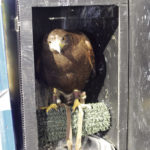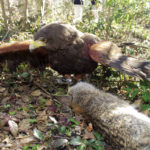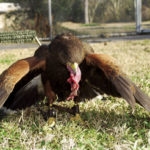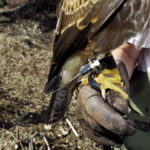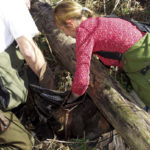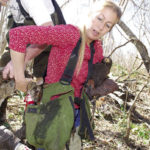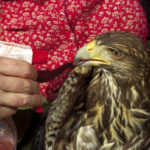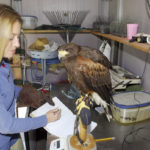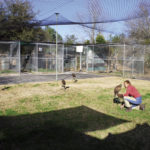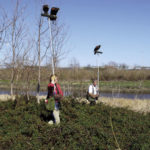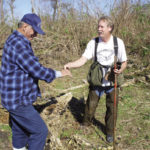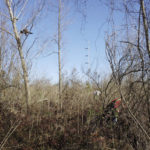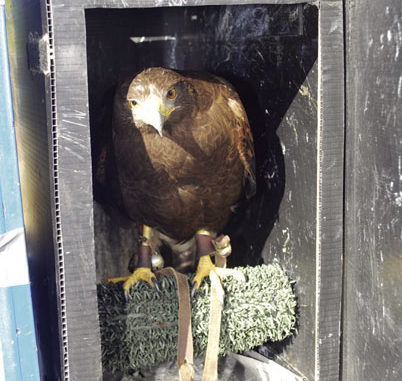
Watching a group of trained hawks swoop down on fleeing rabbits is unlike anything else in hunting.
The end for the big swamp rabbit came quickly and silently. Without warning, a shadow fell from the sky into the dense brush. The first shadow was followed by a second one, just as silent. It was slow motion, but at the same time it was over so swiftly and efficiently that I wondered if I really saw anything at all.
Only when I heard the cry of astonishment from the man in the blue plaid shirt, “He got ’um. He got ’um. I’ll be danged, he got ’um!” was I sure that I saw what I thought I saw.
Before today, my vision of someone who hunted with hawks was of a dark-eyed, regal Arab sheik, clothed in a flowing white thobe and riding on a hot-blooded dapple-gray Arabian mare.
Boy, did I have a lot to learn.
Earlier that morning, I met my hawkers, Jenn and Tom Coulson, at their home in Pearl River. It wasn’t hard to find their home. Half of their big back yard was a huge flight cage, with smaller breeding cages around the perimeter. As soon as I stepped out of my truck, some of the birds screamed in discomfort at a stranger in their midst.
Tom, fair-skinned, 6 feet tall, with a sandy-gray Fu Manchu moustache, has been a hawker for 45 of his 62 years. He retired as a medical technologist from LSU Medical School, where he conducted alligator research between his other duties.
Jenn, at 45, has “only” been a hawker for 27 years. The slender, almost petite blond has impressive credentials. She holds a Ph.D from Tulane University in ecology and evolutionary biology, and conducts long-term, grant-funded research through the Orleans Audubon Society on swallowtail kites.
Besides the Orleans Audubon Society, she belongs to the Raptor Research Foundation, the Association of Field Ornithologists and the American Ornithologists Union. Both Jenn and Tom belong to the North American Falconers Association.
Both are fit and trim. Later, I find out why.
With six Harris’s hawks, each in its own homemade light-weight hawk box in the back seat of the extended cab pickup truck, the three of us squeeze into the front seat. Strange as it sounded, we were headed from the country to the city to hunt, the exact reverse of what most people do.
Once grandly planned as an extension of a shining metropolis, New Orleans East, victim to soils poorly suited for supporting buildings, a decaying economy and the final whammy of Hurricane Katrina, is being reclaimed by nature. But those soils, explained Tom, are much richer than the soils north of Lake Pontchartrain, and produce a lot more wildlife, like rabbits, than do the soils north of Lake Pontchartrain.
I suspected that the fact that the prohibition against hunting with firearms anywhere in Orleans Parish probably contributes a little bit to the large rabbit population there as well.
On the drive south, the Coulsons gave me a thorough primer on hawking, or falconing — which is it? They explained that if one hunts exclusively with falcons, he or she is a falconer. On the other hand, if a person hunts with hawks, either hawker or falconer can be applied to them. I decide that Jenn and Tom are hawkers.
Hawks and falcons have distinct differences. Falcons have pointed wings and are deep-chested and built for speed and aerial pursuit. Hawks have broader, rounded wing tips and are flat-chested. They are best adapted for hunting ground quarry, although they do well with some birds like quail.
Hawks are quicker on the take-off, but slower on long runs. The birds that the pair uses for hunting now are exclusively Harris’s hawks. Like with many other raptors, female Harris’s hawks, ranging from 26 to 37 ounces, will be larger than males, which are typically 18 to 25 ounces.
The size disparity means that males and females can be used for different things. Males are better for quail hunting or for hunting when paired up with dogs to flush game. Females are better for bigger game. They also are not as wide-ranging as males, making them better for hunting in small patches of habitat.
Still, even with their larger size, females are only about half the size of a large swamp rabbit, today’s quarry. They had five females and one male with them for the hunt.
The Coulsons are sold on Harris’s hawks.
“They are one of the few raptors that will hunt in groups,” Jenn explained. “The teamwork is really exciting. They seem more intelligent too, probably because of their social lifestyle.”
“Our birds follow us like a pack of dogs,” added Tom. “You’ll see.”
“Harris’s hawks are adapted to life in arid areas,” Jenn said, “so they can handle the heat here really well. In 80- to 90-degree heat, a red-tailed hawk wouldn’t be very active and might not even want to come back to you.”
She finishes up by explaining that another reason they like the species is that they are adaptable: “They can adjust to almost any situation— thick woods or open desert.”
It was a beautiful day for hawking. In an interlude between two cold fronts, it was cool enough to be active without sweating, but not bitter cold. The skies were cobalt blue, and only the faintest of winds whispered. Strong winds make it difficult to follow the sound of the bells on the hawks’ jesses, they explained.
Tom piloted the truck around the abandoned paved streets of a part of New Orleans that never was. Bridges over canals led to nowhere. The only break in the drab grays and browns of the winter vegetation was the greenish burgundy hue of dewberry briars — of which there were plenty.
“This is ugly and scruffy,” said Tom half-apologetically. “This is where we like to hunt. It was once a beautiful forest before Katrina — all gone.”
I could imagine that it looked better once, but the hand of man was everywhere. Concrete chunks, old tires, pieces of culverts, pieces of moldering lumber and old cans and bottles peppered the briar patches and beat-up trees.
In breaks in the trees in several directions, housing developments and condominiums, many of them appearing to be unrestored this many years after the hurricane, were visible. To the south stood the abandoned theme park, Jazzland. The humps of its roller coaster stood sentinel in silence.
As their truck crept around the area’s roads, the duo’s heads swiveled constantly. They want to avoid electrical lines and transformers.
“Electrical things are really our enemies,” explained Tom. “They kill a lot of hawks. We have to think for our birds. It’s one of the stressful things about hawking.”
“Roads are bad too,” added Jenn. “Road kills attract hawks to where cars can hit them. It’s one of our biggest sources of mortalities.”
Finally satisfied that an area looked safe, Tom pulled the truck to the side, and they dismounted. As Jenn readied her gear and Tom pulled on a set of chaps, a Chevy truck puttered up to them and an impassive-faced man in his 70s stepped out and approached them with deliberation. Tom threw Jenn an “uh oh, what now?” look.
The man was wearing a blue plaid flannel shirt and white shrimpers’ boots. With wonderful 9th Ward elocution so rarely heard anymore, he asked, “Whachu doin’ here?”
Tom patiently and cautiously explained that they were hawkers, out for a day’s excursion. The man’s face softened a bit, and he introduced himself as “Gustav.” He explained that he used to hunt this whole area “in the old days.”
Then, more informing than asking, he told the Coulsons that he was going to accompany them on the hunt. “I heard about dis: I wanna see it.”
Four hawks, Storm, Sky, Winona and Linnzi, were used on the hunt. The first three were adults; Linnzi was a subadult. All four were straining at their jesses (the leather thongs on their feet). They were anxious and excited to hunt.
The Coulsons turned them loose one at a time, after fastening a telemetry transmitter to one leg of each bird. The hawks screamed and flew from tree to tree in excitement.
Tom and Jenn moved into the brush and began beating it with sturdy “beating sticks.” They moved quickly and avoiding open areas, dove from one brushpile and briar patch to the next, the whole time flailing away with their beating sticks. Now I knew why they were so trim. They do this almost every day during hunting season.
They were tough to keep up with, but Gustav measured them step for step, narrating to himself the whole way, “How you like dis? You gotta work your butt off to do dis. How you like dis?”
When the Coulsons began beating the bushes, their hawks immediately became silent and stayed that way the rest of the hunt. They did indeed follow the hunters like a pack of dogs, flying from tree to tree and watching carefully for game.
The two hunters constantly encouraged their birds with shouts, just like rabbit hunters do with beagles: “Get up here, boy. Move up here.” When they flushed a rabbit, the shouts turned to: “Ho, ho, ho.”
As soon as the hawks made the first kill, Jenn ran, almost sprinting through the brush to the site. Once there, she struggled to control the still live rabbit and at the same time remove the birds’ talons from it. The hawk didn’t give up its kill easily.
Jenn quickly dispatched the rabbit and made a slight cut on its neck, then allowed the bird that made the kill to take a tidbit of flesh.
“Not too much, or they don’t hunt,” she explained.
After stowing the rabbit in her vest, she launched the two hawks from her heavily gloved fist, one at a time, back toward the trees. The hunt resumed.
The second kill came soon, with Gustav doing the play-by-play again: “I heard dat. He got ’um! He got ’um!”
The rabbit was screaming piteously, but that didn’t stop it from dragging the much smaller hawk deep into the tangled berry briars.
After the two hunters dug the rabbit and hawk out of the briars and stowed the bunny in Jenn’s vest, she spritzed the hawk’s mouth with water from a spray bottle, just like she did after the first kill. The hawk seemed to visibly relish the refreshment.
Gustav followed the hunt closely, but courteously.
“I doan wanna mess dem boids up,” he explained in perfect downtown dialect.
The third kill was exciting, with three birds participating. Untangling them from the rabbit and the briars was difficult, and as with most of the kills, two sets of hands made the work easier. Tom carried two of the hawks away from the kill site, but one immediately returned. She still wanted to be in on the kill.
Just as excited was Gustav.
“I like that! I like that!” he repeated over and over with a heavy emphasis on “like.”
After the third strike, Tom lost track of one of his birds, always a fear for a hawker. He scanned the trees around him. He called. He looked in a hollow log. Gustav, thinking that he is looking for a rabbit in the log, volunteered that with a long vine he could get the rabbit out.
Tom thanked him and said, “No.”
Intrigued, Gustav asked why.
“I’m doing this for the sport,” explained Tom. “I don’t need to kill every rabbit out here.”
Tom’s answer left Gustav even more puzzled. Gustav obviously was, and probably still is, an expert hunter.
The fourth rabbit to go down was another screamer. Gustav was still obviously enjoying the hunt.
“Dey got his ass! Dey got him, he-he.”
Near lunch, Gustav took his leave from the two hunters. He cordially shook hands with Tom and tipped his cap to Jenn.
“Dis is a kick! Dis is good! I wish I knew about dis when I was younger.”
Tom replied with a delighted grin.
Next stop for the pair was to get Vietnamese po-boy bread at the Dong Phuong Bakery in the New Orleans East neighborhood known as “Little Saigon.” With their purchase, the Coulsons repaired to a deserted road decorated with a discarded sofa and other goodies near one of the bridges to nowhere to enjoy lunch. Oddly, it was peaceful and in its own way, it was beautiful.
The afternoon hunt was to be different, they explained. There would be few or no trees in the area for the hawks to perch in as they watched for game. So the Coulsons would be carrying their raptors on top of 8-foot-tall T-perches.
As promised, except for a small number of scrubby tallow trees near a canal, the tallest plants around were the dead stems of the giant ragweeds that obviously dominated the area in the summer. But the whole spot was blanketed by an almost solid growth of dewberry briars. Perfect rabbit habitat.
Three hawks participated in this hunt, Storm, Grayson (a male) and Tipitina. The two hunters waded into the briars. With their hawks held high on their T-perches, they looked like nothing so much as standard bearers carrying their standards into battle.
Tipitina struck first. By the time Tom and Jenn got there, the big swamper had dragged its tormenter out of sight, deep into a snarled tangle of briars. The hunters literally had to dig their bird out, but they retrieved it and the rabbit.
Within minutes after resuming the hunt, all three birds wheeled and swooped in at one time to strike another rabbit. As Jenn worked hard to untangle the birds and rabbit from the vegetation, Tom picked up Storm, the first bird out, and resignedly said, “Oh gee, she broke a talon.”
He walked away from the action, using his thumb to staunch the free flow of blood from the damaged foot. While the bird would recover fully from the damage, especially since it wasn’t to the first or second talon, what are called the power talons, they decided to call the hunt over with six rabbits in the bag, not bad for three hours in the brush.
While the hunt was over, their day wasn’t. Keeping raptors is a demanding hobby, especially for raptor breeders like the Coulsons, who maintain 35 hawks. Nutria they have purchased from trappers and rats that they have raised have to be cut up to feed the birds. And the six hawks that they keep in hunting shape have to be weighed to the nearest gram, an important daily duty for any hawker who wants to keep his or her birds in shape.
